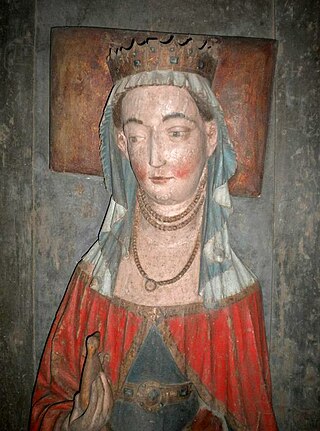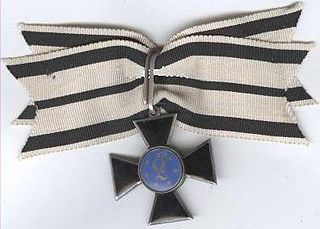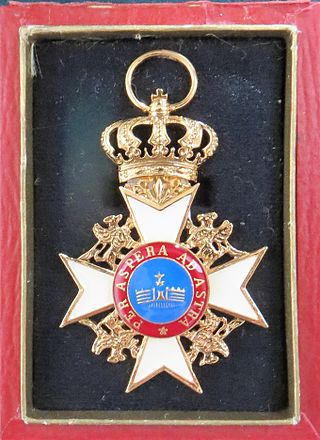| Gender | Female |
|---|
Richardis is a feminine given name, from Germanic rik ("ruler") and gard ("enclosure" or "yard"). It is unrelated to the name Richard, which is from rik and hard ("hard", "brave", "powerful"). Notable people with the name include:

Albert was King of Sweden from 1364 to 1389 and Duke of Mecklenburg-Schwerin from 1384 to 1412.
Elisabeth of Austria may refer to:

Valdemar III (1314–1364) was King of Denmark from 1326 to 1329, while he was underage; he was also Duke of Schleswig as Valdemar V in 1325–26 and from 1330 to 1364. He was a rival king set up against the unsuccessful Christopher II and was widely opposed by his subjects. His term was ended when he abdicated. Sometimes the earlier King Valdemar the Young (c. 1209–1231) is also referred to as Valdemar III.
Margaret of Austria may refer to:
Ingeborg is a Germanic feminine given name, mostly used in Germany, Denmark, Sweden and Norway, derived from Old Norse Ingiborg, Ingibjǫrg, combining the theonym Ing with the element borg "stronghold, protection". Ingebjørg is the Norwegian most used variant of the name, and Ingibjörg is the Icelandic variant.

Euphemia of Sweden was a Swedish princess. She was Duchess consort of Mecklenburg, heiress of Sweden and of Norway, and mother of King Albert of Sweden. (c. 1338-1412) .
Anne of Bohemia may refer to:
Kunigunde, Kunigunda, or Cunigunde, is a European female name of German origin derived from "kuni" and "gund" (war). In Polish this is sometimes Kunegunda or Kinga. People with such names include:

Richardis of Schwerin was Queen of Sweden as the consort of King Albert.

The Order of Louise was founded on 3 August 1814 by Frederick William III of Prussia to honor his late wife, the much beloved Queen Louise. This order was chivalric in nature, but was intended strictly for women whose service to Prussia was worthy of such high national recognition. Its dame companion members were limited to 100 in number, and were intended to be drawn from all classes.

The House of Estridsen was a dynasty that provided the kings of Denmark from 1047 to 1412. The dynasty is named after its ancestor Estrid Svendsdatter. The dynasty is sometimes called the Ulfinger, after Estrid's husband, Ulf Jarl. The dynasty also provided three medieval rulers of Sweden and one of Norway. Their family coat of arms became the coat of arms of Denmark and therefore influenced the coat of arms of Tallinn and the coat of arms of Estonia.
Ingeborg of Denmark was the eldest daughter of Valdemar IV of Denmark and his wife Helvig of Schleswig. By marriage she was Duchess of Mecklenburg, although she died before her husband succeeded her father-in-law. She was potential heiress to the Danish throne and was the older sister of Margaret I of Denmark.
Richardis of Schwerin, also called Richardis of Lauenburg or Rixa,, was a Duchess consort of Schleswig and possibly a Danish queen consort, married to Valdemar III of Denmark. She was the daughter of Gunzelin VI, Count of Schwerin-Wittenburg and Richardis of Tecklenburg. She was the aunt of Richardis of Schwerin, Queen of Sweden.
Richardis of Schwerin may refer to:
Princess Amalia or Princess Amalie may refer to:
Richardis Catherine of Mecklenburg, was a Princess of Sweden and Mecklenburg, and by marriage a Margravine consort of Moravia and Duchess consort of Görlitz (Lusatia), daughter-in-law of the Holy German Emperor.
Gunzelin VI of Schwerin was a son of Count Niklot I of Schwerin and his wife, Elisabeth of Holstein. In 1323, he succeeded his father in Schwerin-Wittenburg.

The House Order of the Wendish Crown is a dynastic order that was jointly instituted on 12 May 1864 by Grand Duke Friedrich Franz II of Mecklenburg-Schwerin and Grand Duke Friedrich Wilhelm of Mecklenburg-Strelitz. It is the oldest and most senior order of the House of Mecklenburg.
Hedwig is a German feminine given name, from Old High German Hadwig, Hadewig, Haduwig. It is a Germanic name consisting of the two elements hadu "battle, combat" and wig "fight, duel". The name is on record since the 9th century, with Haduwig, a daughter of Louis the German. The name remained popular in German high nobility during the 10th and 11th centuries. Other medieval spellings include Hathuwic, Hathewiga, Hadewich, Hadewic, Hathwiga, Hadwich, Hatwig, Hadwig, Hediwig, Hedewiga, Hedewich, Hedewiih, Hatuuih, Hetvic, Haduwich, Hadawich, Hatuwig, etc. Forms such as Hadiwih, Hadewi etc. suggest that the name is the result of a conflation of two separate names, one with the second element wig "fight", the other with the second element wih "hallowed".